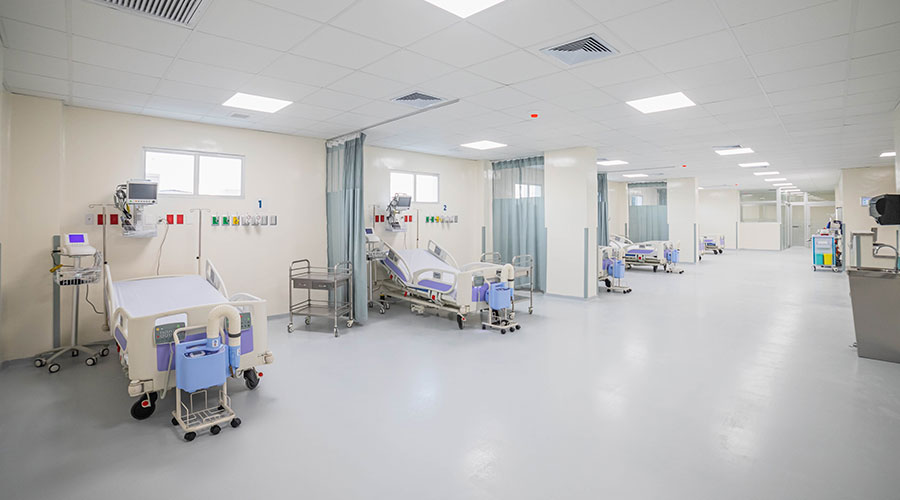Hospital associated infections (HAI) kill more than 75,000 people in the United States every year. This astounding death rate is greater than the annual combined deaths from AIDS, breast cancer, and auto accidents. In fact, the CDC, has indicated its concern regarding the overall threat of infectious diseases, by awarding over $200M to address “threats posed by emerging and re-emerging infectious diseases.”
What is equally astounding is that HAIs can be mitigated at a minimum through relatively low cost and readily available technologies. These same technologies are also capable of helping slow the rising death rate from antibiotic-resistant microbes (ARMs), which the World Health Organization has characterized as a global concern.
Since the 1930s, many hospitals have relied upon Ultraviolet-C (UV-C) energy to control airborne infectious diseases, but use waned with the arrival and proliferation of antibiotics. In the 1990s, demand for the technology returned following a resurgence of drug resistant infectious microorganisms, which required additional infection control measures (Reed 2010).
Ultraviolet light in the 254-nm wavelength “C” band (UV-C), is emitted by lamps that are very similar in design and construction to fluorescent lamps (Fencl 2013). UV-C light is particularly effective at killing microbes in whatever medium the microbes are colonizing. Applying UV-C lamps for such a purpose is often called ultraviolet germicidal irradiation (UVGI) and typically includes:
• Disinfecting the air in the upper level rooms
• Disinfecting ventilation air streams in HVAC systems
• Cleaning and keeping clean the surfaces of air-handler cooling coils and drain pans
• Surface disinfection in hospital patient rooms
• Sterilizing medical equipment
This article advises that UV-C technologies stand ready to contribute to facility-wide strategies for reducing HAIs and ARMs without adding to their resistance to medicinal treatments.
Airborne HAIs
Hospital acquired infections are also called nosocomial infections. They are transmitted by a variety of vectors, including person-to-person, through injection/insertion of medical devices, airborne contact of open wounds, and by respiration of airborne particles.
While this article focuses on airborne pathogens, recent research complicates our understanding of transmission vectors and engineering appropriate preventive measures. For example, C. difficile, which is picked up from surfaces and person-to-person contact, is linked to at least 14,000 American deaths each year. (USDHHS, CDC 2013). Recent studies have shown that while understood primarily as a contact pathogen, C. difficile can be transmitted as an airborne infectious agent (King et. al., 2012; Roberts et. al. 2008; Best et. al 2010). While C. difficile infections can happen anywhere, most deaths from antimicrobial resistant forms are from hospital associated infections (USDHHS, CDC 2013).
HAI rates have long been a concern to hospitals; and some gains are being made in reducing them (CDC 2014). However, new threats appear almost every year, such as Severe Acute Respiratory Syndrome (SARS) and Middle East Respiratory Syndrome (MERS). Emerging diseases require time and resources to develop protocols for diagnosing, isolating and treating associated illnesses. During these developmental phases, healthcare workers are particularly vulnerable to emerging diseases, as was the case in Saudi Arabia and the United States with respect to MERS (CDC PR 2014). Note: Although the means of MERS transmission is not known, current protocols require standard, contact, and airborne isolation precautions (CDC Web 2014).
Airborne ARMs
The CDC estimates that in the United States, more than two million people are sickened every year with antibiotic-resistant infections, with at least 23,000 dying as a result (USDHHS, CDC 2013). The most dangerous are those that have the potential to spread by the airborne route (Kowalski 2006). Many of these pathogens are now called “superbugs” since they are virtually invincible to standard drug treatments.
ARMs are worth mentioning in the context of UVGI because UVGI is a mechanical means for destroying microbes. UVGI disrupts microbe DNA sequencing at the cellular level, which causes cell death. Microbes cannot build a resistance to UVGI.
The World Health Organization, U.S. Dept. of Health and Human Services, and Centers for Disease Control are united in their classification of ARMS being a global concern (USDHHS, CDC 2013; WHO 2014). The WHO states that “resistance to common bacteria has reached alarming levels in many parts of the world and that in some settings, few, if any, of the available treatment options remain effective for common infections.” The CDC report states, “Antimicrobial resistance is one of our most serious health threats. Infections from resistant bacteria are now too common…”
ARM infections are on the rise, threatening not only patients, but healthcare professionals and facility staff, as well. Support for the claim that the rate of airborne transmission of infections is also growing (Fletcher et al. 2004). Evidence exists for airborne nosocomial transmissions of Acinetobacter, Pseudomonas, and MRSA (Allen and Green 1987, Ryan et al 2003 and Farrington et al. 1990). Airborne transmission is a significant threat because it can cause infections to spread rapidly and extensively through a non-immune population (Weinstein 2004). Therefore, source and pathway management should involve airborne transmission and, consequently, enhanced methods of control even though the primary route is considered to be direct contact.
Much attention is focused today on pathogenic microorganisms that have developed resistance to antibiotic treatment, or entire types or classes of antibiotics. The loss of effective antibiotic treatment undermines the ability of healthcare to fight infectious diseases and manage the infectious complications common among immunocompromised patients (USHHS, CDC 2013).
Ultraviolet germicidal irradiation
UVGI helps combat ARMs and, more generally, HAIs, by decreasing their concentration in facilities. For all ARMs classified by the CDC and U.S. Dept. of Health and Human Services, the first of a four-part strategy for combating them is “Preventing infections from occurring and preventing resistant bacteria from spreading.” UVGI is particularly effective for addressing this strategy.
How UVGI systems work and how they are addressed through lifecycle considerations of design, installation, commissioning, operations, and maintenance has been described in a number of technical articles published by engineering magazines.
For all its strengths, UVGI is not a stand-alone means to combat airborne HAIs and ARMs. UVGI systems are supplemental to air filtration, air-pressure control and basic procedures for controlling particulate matter during construction and renovation activities (Memarzadeh, et. al. 2010).
UVGI is listed as a supplemental strategy for airborne infectious agents in several important guidelines, including ASHRAE Standard 170-2013, ANSI/ASHRAE/ASHE 170:Ventilation of Health Care Facilities and the 2009 ASHRAE Guideline for Indoor Air Quality, which has been incorporated into the 2010 and 2014 editions of the Facility Guideline Institute (FGI) Guidelines for Hospitals and Outpatient Facilities. Another is the 2009 ASHRAE Indoor Air Quality Guide.
Guidance for sizing/selecting UV-C lamps; installation and commissioning procedures, and operations and maintenance guidance, can be found in recent ASHRAE Handbooks and trade-publication articles.
UV-C applications
Upper-air/room
The primary objective of upper-air UV-C placement is to interrupt the transmission of airborne infectious diseases in patient rooms, waiting rooms, lobbies, stairwells, laundry chutes, and emergency entrances and corridors. All of these spaces can be effectively and affordably treated with UV-C (ASHRAE 2011). Airborne droplets containing infectious agents can remain in a well-ventilated room for as long as six minutes. Upper-air UV-C fixtures can inactivate them in fractions of a second. Operating 24 hours a day, upper-air systems are especially effective at significantly reducing airborne infectious microorganisms and eliminating the potential viability of surface microbes that eventually settle out of room air.
Infections from airborne pathogens are usually spread by people (Nardell and Macher: ACGIH 1999). Upper-air systems control infections at their source by intercepting pathogens in the room where occupants generate them (First et al. 1999). Upper-air systems have been shown to be effective against airborne viruses and bacteria, including chickenpox, measles, mumps, varicella, TB, and viruses that cause colds. Studies of Mycobacterium tuberculosis have shown that equivalent air exchange rates of 10–25 ACH can be achieved (CDC 2005). In a study by Escombe et al. (2009), guinea pigs were exposed to exhaust air from a TB ward whereby 35 percent of the controls developed TB infections while only 9.5 percent (a 74 percent reduction) developed infections when upper-air UV-C was used.
Measles and influenza viruses and the tuberculosis bacteria are infectious diseases known to be transmitted by means of shared air between infected and susceptible persons. Studies indicate two transmission patterns: (I) within-room exposure such as in a waiting room or patient room; (II) transmissions beyond a room through corridors, and through entrainment within ventilation ductwork where air is then recirculated throughout the building. Since the 1930s (Wells 1955; Riley and O’Grady 1961) and continuing to the present day (Miller et al. 2002; Xu et al. 2003; First et al. 2007), numerous experimental studies have demonstrated the efficacy of upper-air UV-C for reducing concentrations of infectious agents for all three patterns. Compared to fixtures used in these studies, newer fixtures are available today that provide greater UV-C output and coverage, are less costly, use less power and are less expensive.
Air conditioning systems
A/C systems provide an excellent setting for surfaces that support the growth of bacteria and mold in and around cooling coils, drain pans (Levetin et al. 2001), plenum walls and air filters. Growth of these microbial deposits also leads to coil fouling, leading to an increase in coil-pressure drop and reduction of airflow and heat exchange efficiency (Montgomery and Baker 2006). As performance degrades, so does the quality, amount and pressurization capability of air supplied to conditioned spaces (Kowalski 2006/2009).
Because most hospital codes call for the high-efficiency (HEPA) filters to be located downstream of the cooling coil, the filters can become damp or wet. As such, they should be considered as a potential growth medium and infectious disease reservoir. ASHRAE recommends UV-C lighting to be installed downstream of the cooling coil. If a 360-degree UV-C system is installed as such, it will disinfect both the cooling coil and the filter to eliminate mold and bacteria in and upon both devices. It should be noted that a common coil irradiation installation, using a 360 degree lamp system, will also provide up to a 35 percent kill ratio of tuberculosis in the airstream over and above the air filter’s removal rate (Kowalski 2009).
Conclusions
Although UV-C systems providing ultraviolet germicidal irradiation have been used for more than 70 years, their application in infection control settings in hospitals has waxed and waned several times. Given the concerning rates of morbidity and mortality of hospital associated infections, and the global concern for antimicrobial resistant microorganisms, healthcare professionals may want to examine currently available UV-C technologies that address airborne infectious agents. In particular, upper-room UV-C systems and UV-C systems that irradiate interior surfaces of air handling units, both of which operate continuously, can greatly reduce concentrations of pathogens in a highly reliable and cost effective fashion.
Extensive documentation exists on the efficacy of UV-C systems, and guidelines for considering and applying UV-C systems exist in ASHRAE standards and publications that have been developed collaboratively with healthcare associations and professionals.
Daniel Jones is the The president and co-founder of UV Resources , Santa Clarita, Calif.
Reference
ACGIH. 1999. Bioaerosols: Assessment and control, Ch. 9: Respiratory infections—Transmission and environmental control, by E.A. Nardell and J.M. Macher. American Conference on Governmental Industrial Hygienists, Cincinnati, OH.
Allen K, Green H. 1987. Hospital outbreak of multi-resistant Acinetobacter anitratus: An airborne mode of spread? J Hosp Infect 9:110–119.
ASHRAE, 2011 Handbook – HVAC Applications, Chapter 60 – Ultraviolet Air And Surface Treatment. Atlanta, GA.
ASHRAE, 2012 Handbook – Systems and Equipment, Chapter S17, Ultraviolet Lamp Systems. . Atlanta, GA.
Best et. al 2010. Emma L. Best, Warren N. Fawley, Peter Parnell, and Mark H. Wilcox, “The Potential for Airborne Dispersal of Clostridium difficile from Symptomatic Patients.” Clinical Infectious Diseases, Volume 50, Issue 11.
CDC. 2005. Guidelines for preventing the transmission of Mycobacterium tuberculosis in health-care settings. Morbidity and Mortality Weekly Report (MMWR) 37-38, 70-75.
CDC 2014. Centers for Disease Control and Prevention, National and State Healthcare Associated Infections Progress Report, March 2014
CDC PR 2014. Press Release. CDC announces second imported case of Middle East Respiratory Syndrome (MERS) in the United States. Downloaded from http://www.cdc.gov/media/releases/2014/p0512-US-MERS.html on May 19, 2014.
CDC Web 2014. Web page. Interim Infection Prevention and Control Recommendations for Hospitalized Patients with Middle East Respiratory Syndrome Coronavirus (MERS-CoV). Accessed http://www.cdc.gov/coronavirus/mers/infection-prevention-control.html online on May 19, 2014.
Duvlis Z, Drescher J. 1980. Investigations on the concentration of air-borne germs in conventionally air-conditioned operating theaters. Zentralbl Bakteriol [B] 170(1–2):185–198.
Escombe, A.R., R.H. Gilman, M. Navincopa, E. Ticona, B. Mitchell, C. Noakes, C. Martínez, P. Sheen, R. Ramirez, W. Quino, A. Gonzalez, J.S. Friedland, and C.A. Evans. 2009. Upper-room ultraviolet light and negative air ionization to prevent tuberculosis transmission. PLoS Med 17(6).
Farrington M, Ling T, French G. 1990. Outbreaks of infection with methicillin-resistant Staphylococcus aureus on neonatal and burns units of a new hospital. Epidem Infect 105:215–228.
First MW, Nardell EA, Chaisson W, Riley R. 1999. Guidelines for the application of upper-room ultraviolet germicidal irradiation for preventing transmission of airborne contagion – Part II: Design and operational guidance. ASHRAE J 105:869–876.
First, M.W., F.M. Rudnick, K. Banahan, R.L. Vincent, and P.W. Brickner. 2007a. Fundamental factors affecting upper-room ultraviolet germicidal irradiation—Part 1: Experimental. Journal of Environmental Health 4: 1-11.
Fencl 2013. Forrest Fencl. “Illuminating Info: UV-C For HVAC,” Engineered Systems, September, 2013. Available at http://bit.ly/1iygqXH.
Fletcher LA, Noakes CJ, Beggs CB, Sleigh PA, Kerr KG. 2003. The Ultraviolet Susceptibility of Aerosolized Microorganisms and the Role of Photoreactivation. Vienna: IUVA.
Greenheck, 1999 – Product Application Guide, Fan Application No. FA/100-99
King et. a. 2012. M.F. King, C.J. Noakes, P.A. Sleigh, M.A. Camargo-Valero, 'Bioaerosol Deposition in Single and Two-Bed Hospital Rooms: A Numerical and Experimental Study' Building and Environment (2012) is available to download (DOI10.1016/j.buildenv.2012.09.011)
Kowalski, W.J. 2006. Aerobiological engineering handbook. McGraw-Hill, New York.
Kowalski, W. 2009. Ultraviolet germicidal irradiation handbook. Springer-Verlag, Berlin.
Kundsin R. 1976. Operating Room as a Source of Wound Contamination and Infection. National Research Council, National Academy of Sciences, pp. 167–172.
Levetin, E., R. Shaughnessy, C. Rogers, and R. Scheir. 2001. Effectiveness of germicidal UV radiation for reducing fungal contamination within air-handling units. Applied and Environmental Microbiology 67(8):3712-3715.
Mangram AJ, Horan TC, Pearson ML, Silver LC, Jarvis WR, HICPAC. 1999. Guideline for prevention of surgical site infection. Am J. Infect Control 27(2): 97–132.
McLean R. 1961. The effect of ultraviolet radiation upon the transmission of epidemic influenzain long-term hospital patients. Am Rev Resp Dis 83:36–38.
Memarzadeh, et. al. 2010. Farhad Memarzadeh, Russell N. Olmsted, and Judene M. Bartley, “Applications of ultraviolet germicidal irradiation disinfection in health care facilities: Effective adjunct, but not stand-alone technology.” American Journal of Infection Control, June 2010. Vol. 38 No. 5 Supplement 1.
Moggio M, Goldner JL, McCollum DE, Beissinger SF. 1979. Wound Infections in Patients Undergoing Total Hip Arthroplasty. Ultraviolet Light for the Control of Airborne Bacteria. Arch Surg 114(7):815–823.
Montgomery, R. and R. Baker. 2006. Study verifies coil cleaning saves energy. ASHRAE Journal 48(11):34-36.
R M Ryan, G E Wilding, R J Wynn, R C Welliver, B A Holm, C L Leach. Effect of enhanced ultraviolet germicidal irradiation in the heating ventilation and air conditioning system on ventilator associated pneumonia in a neonatal intensive care unit. Journal of Perinatology advance online publication 24 March 2011; doi: 10.1038/jp.2011.16
Reed 2010. Nicholas G. Reed, “The History of Ultraviolet Germicidal Irradiation for Air Disinfection.” Public Health Rep. 2010 Jan-Feb; 125(1): 15–27.
Riley, R.L. and F. O’Grady. 1961. Airborne infection—Transmission and Control. Macmillan, New York.
Roberts et. al 2008. Katherine Roberts, Caroline F Smith, Anna M Snelling, Kevin G Kerr, Kathleen R Banfield, P Andrew Sleigh and Clive B Beggs, “Aerial Dissemination of Clostridium difficile spores.” BMC Infectious Diseases, 2008, Volume 8, Issue 7.
USHHS, CDC 2013. U.S. Dept. of Health and Human Services and Centers for Disease Control in Atlanta, Antibiotic Resistance Threats in the United States. 2013.
WHO. 1988. Indoor air quality: Biological contaminants. Copenhagen, Denmark: World Health Organization. Report nr European Series 31.
WHO. 1999. Guidelines for the Prevention of Tuberculosis in Health Care Facilities in Resource Limited Settings. Geneva: World Health Organization. Report nr WHO/CDS/TB/99.269.
WHO 2014. World Health Organization, Antimicrobial resistance: global report on surveillance 2014. April 2014. ISBN: 978 92 4 156474 8.
Weinstein, RA, 2004. Planning for Epidemics — The Lessons of SARS. NEJM 350(23):2332-2334.
Wells WF. 1938. Air-borne infections. Mod Hosp 51:66–69. 232 9 Upper Room UV Systems
Wells WF, Wells MW, Wilder TS. 1942. The environmental control of epidemic contagion; I – An epidemiologic study of radiant disinfection of air in day schools. Am J Hyg 35:97–121.
Wells WF. 1943. Air disinfection in day schools. Am J Pub Health 33:1436–1443.
Wells WF. 1955. Airborne Contagion. Sciences AotNAo, editor. New York: New York Academy of Sciences.
Xu P, Peccia J, Fabian P, Martyny JW, Fennelly KP, Hernandez M, Miller SL. 2003. Efficacy of ultraviolet germicidal irradiation of upper-room air in inactivating airborne bacterial spores and mycobacteria in full-scale studies. Atmos Environ 37:405–419.

 Waco Family Medicine Achieves Savings and Bold Design with Wood Selections
Waco Family Medicine Achieves Savings and Bold Design with Wood Selections Alleged Ransomware Administrator Extradited from South Korea
Alleged Ransomware Administrator Extradited from South Korea Design Plans Unveiled for New Intermountain St. Vincent Regional Hospital
Design Plans Unveiled for New Intermountain St. Vincent Regional Hospital Ground Broken on New Pediatric Health Campus in Dallas
Ground Broken on New Pediatric Health Campus in Dallas Pre-Construction Strategies for Successful Facilities Projects
Pre-Construction Strategies for Successful Facilities Projects